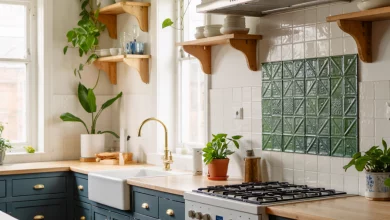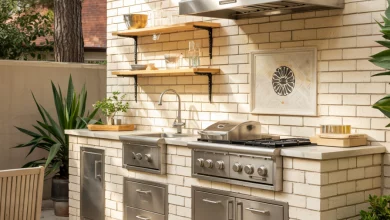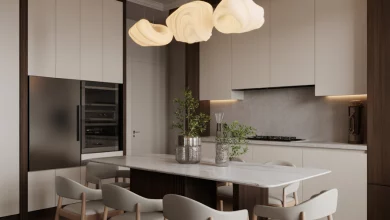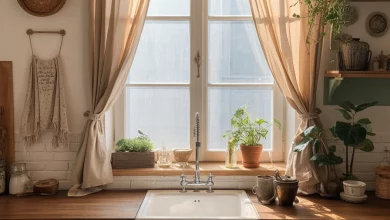Pantry Organization Ideas for 2026
Now that we’re entering 2026, we have a new perspective when it comes to kitchen organization and storage. This is a reality regardless of whether you have a small galley kitchen, a walk-in pantry, or just a small kitchen that flows well with your entire living space. Kitchen organization is a necessity, especially in a family home, so an organized cabinet or pantry is a top need. This article will showcase 10 great ways that you can rearrange your entire storage system in your kitchen to make it more elegant, efficient, and useable. Organization methods include shelving systems, do-it-yourself designs using dollar stores, a farm sink pantry, an Indian spice zone in your kitchen, and healthy snack storage. It’s time to get started.
1. Modular Wire Shelving Systems for Small Spaces
 If you’re working with small spaces, especially in an apartment or compact house, a wire shelf unit is a game changer. These systems offer open visibility and flexible adjustment—perfect for adapting to tall cereal boxes or short snack tubs. I once helped my friend in her studio convert a tiny closet off the kitchen into a mini pantry using a five-tier wire shelving set and labeled baskets for snacks and treats. She found everything at dollar stores and assembled it in under an hour. The airy, see-through nature of wire shelving ensures you’re not battling hidden depths, and keeping it on a budget lets you focus on artful arrangement rather than big spending.
If you’re working with small spaces, especially in an apartment or compact house, a wire shelf unit is a game changer. These systems offer open visibility and flexible adjustment—perfect for adapting to tall cereal boxes or short snack tubs. I once helped my friend in her studio convert a tiny closet off the kitchen into a mini pantry using a five-tier wire shelving set and labeled baskets for snacks and treats. She found everything at dollar stores and assembled it in under an hour. The airy, see-through nature of wire shelving ensures you’re not battling hidden depths, and keeping it on a budget lets you focus on artful arrangement rather than big spending.
2. Walk-In Pantry Zones with Labels and Baskets
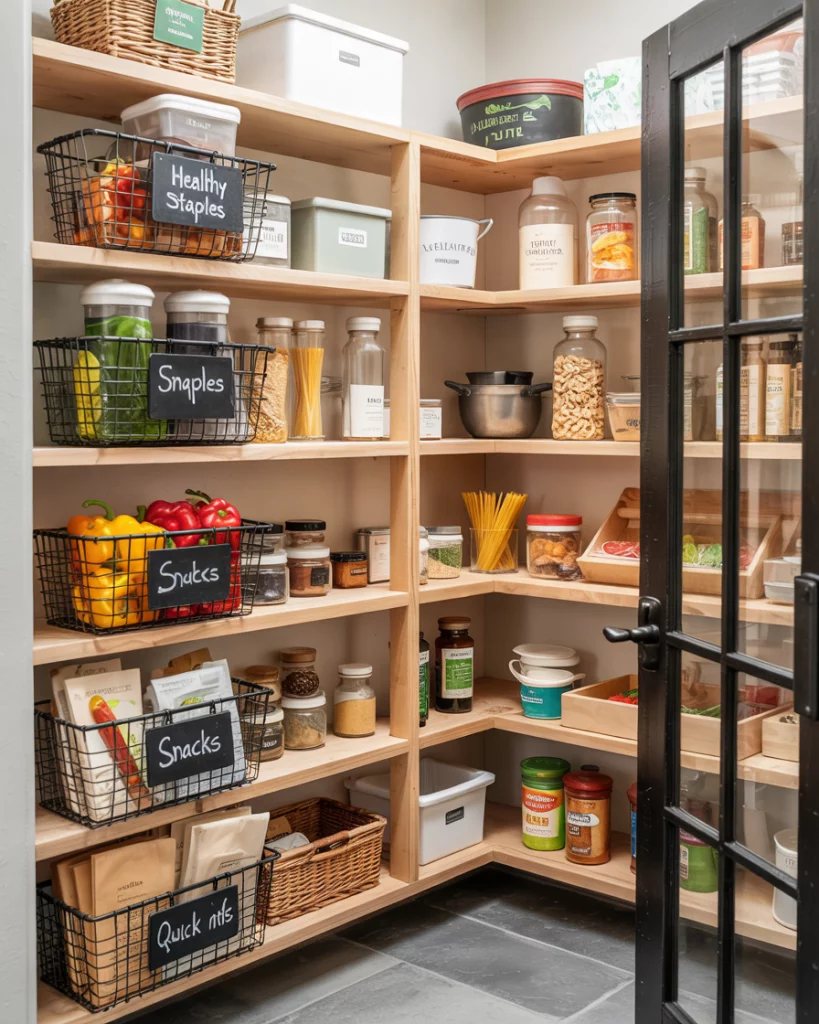 Having a dedicated walk-in pantry is a luxury, but increasingly designers are carving out small rooms or alcoves in new builds (or even converting a spare closet). The key here is zoning: one shelf for quick meals, one for healthy staples, one for kids’ snacks, and one for bulk goods. Use slim containers and add labels so everyone in your household knows where things go—no more “Where did the kid’s granola bars go?” I’ve seen layouts where the inner door holds spice jars and the outer shelves hold cereals and baking supplies, forming an intuitive loop. It keeps your main kitchen cabinet fronts clean and clutter-free.
Having a dedicated walk-in pantry is a luxury, but increasingly designers are carving out small rooms or alcoves in new builds (or even converting a spare closet). The key here is zoning: one shelf for quick meals, one for healthy staples, one for kids’ snacks, and one for bulk goods. Use slim containers and add labels so everyone in your household knows where things go—no more “Where did the kid’s granola bars go?” I’ve seen layouts where the inner door holds spice jars and the outer shelves hold cereals and baking supplies, forming an intuitive loop. It keeps your main kitchen cabinet fronts clean and clutter-free.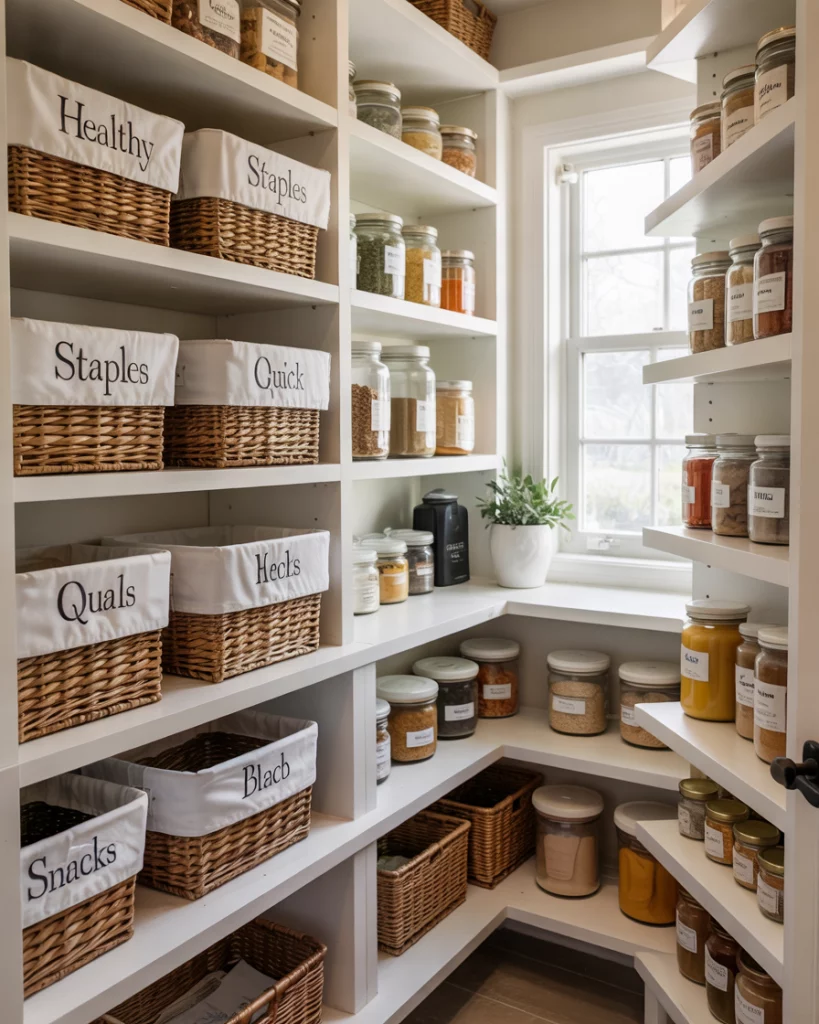
3. DIY Dollar Store Upgrades for Cabinet and Closet Inserts
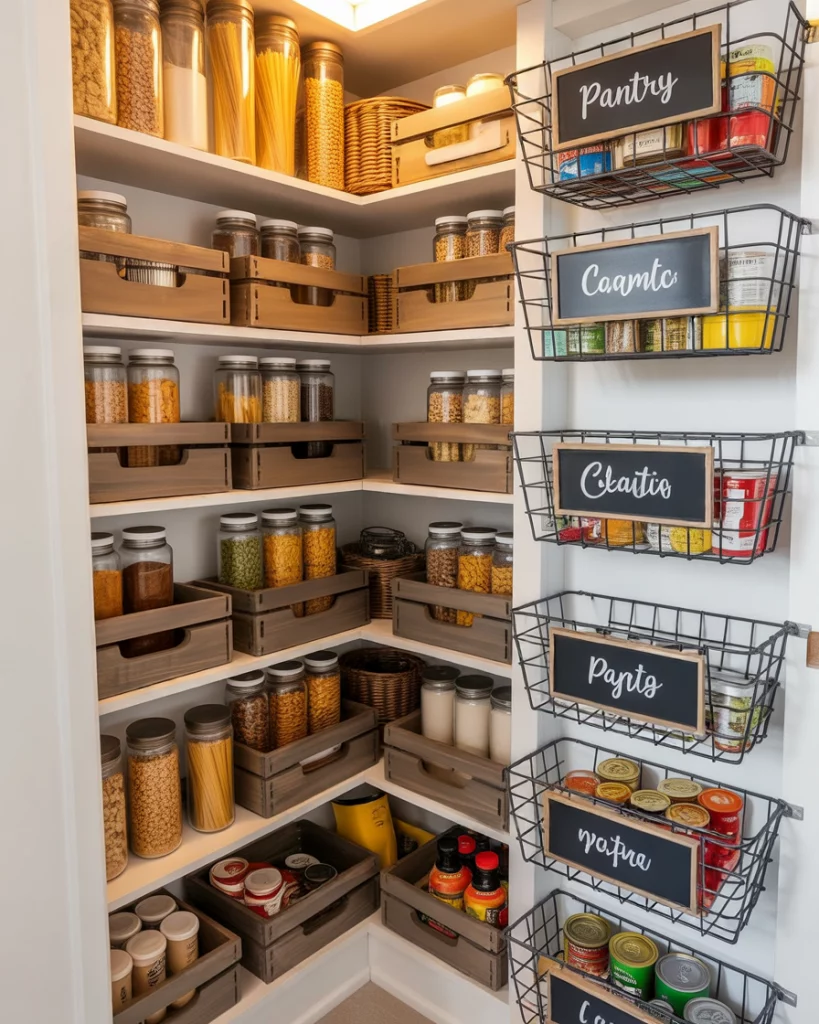 On a shoestring budget? You do not need fancy fixtures. DIYers often use Dollar Tree or dollar stores for cheap crates, lazy Susan turntables, clear containers, or adhesive hooks. You could work your cabinet door or smaller area in a nearby closet near your kitchen into a convenient pantry area. I will never forget when we adhered a chalkboard label to all the crates so we could jot down their contents (and swap ’em out when it was winter versus summer)! By implementing DIY projects that utilize dollar stores, you are adding value without stretching your wallet—a phenomenal strategy for new apartments or beginners!
On a shoestring budget? You do not need fancy fixtures. DIYers often use Dollar Tree or dollar stores for cheap crates, lazy Susan turntables, clear containers, or adhesive hooks. You could work your cabinet door or smaller area in a nearby closet near your kitchen into a convenient pantry area. I will never forget when we adhered a chalkboard label to all the crates so we could jot down their contents (and swap ’em out when it was winter versus summer)! By implementing DIY projects that utilize dollar stores, you are adding value without stretching your wallet—a phenomenal strategy for new apartments or beginners!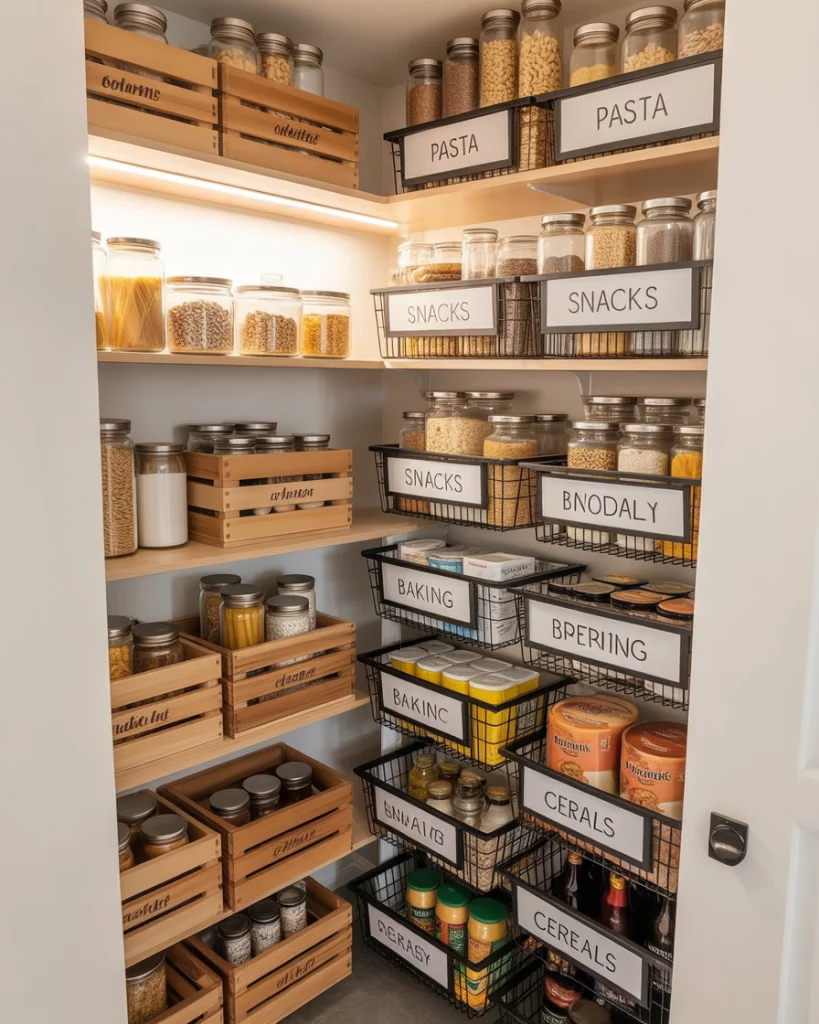
4. Farmhouse-Style Open Shelves with Rustic Labels
 For those drawn to a farmhouse style, open shelves and reclaimed wood shelving boards create a warm, inviting pantry aesthetic. Frame your storage zone with warm wood, add mason jars for dry goods, woven baskets for loose items, and antique metal labels for a dreamy look. I visited a home where the homeowner fixed two rustic planks above her pantry door, painted in soft white, and used black chalkboard paint labels for each basket. The result? Pantry organization that feels more like décor than storage. This works wonderfully in a transitional kitchen where you want your pantry storage to reflect your overall home vibe.
For those drawn to a farmhouse style, open shelves and reclaimed wood shelving boards create a warm, inviting pantry aesthetic. Frame your storage zone with warm wood, add mason jars for dry goods, woven baskets for loose items, and antique metal labels for a dreamy look. I visited a home where the homeowner fixed two rustic planks above her pantry door, painted in soft white, and used black chalkboard paint labels for each basket. The result? Pantry organization that feels more like décor than storage. This works wonderfully in a transitional kitchen where you want your pantry storage to reflect your overall home vibe.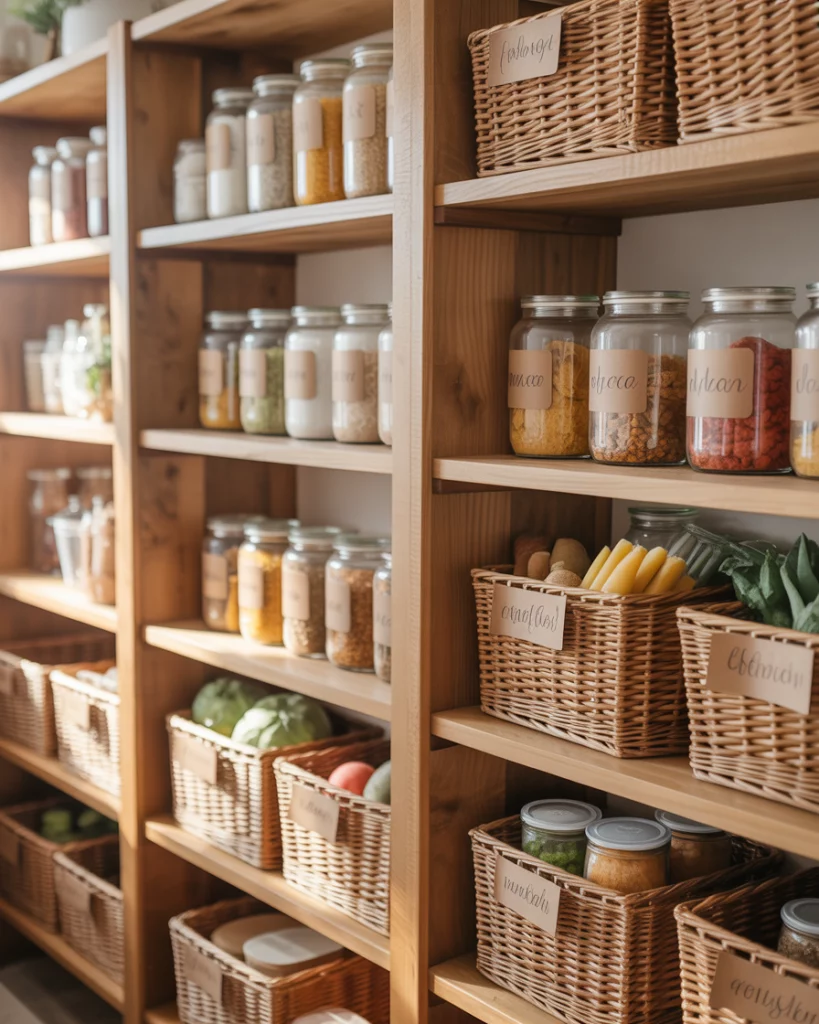
5. Minimalist Hidden Pantry Behind Cabinet Doors
 In 2026 design trends, the idea of a hidden pantry blending seamlessly into the kitchen is gaining traction. You might convert a section of your cabinetry into a disguised pantry—doors that look like your regular cabinetry but open to reveal full shelves, stackable bins, and organization zones. For a minimalist home, this is gold: no visible clutter, everything tucked inside, yet highly accessible. I helped a couple install a pantry behind handleless panels so that from the living area, all you saw were clean lines. Inside, they used clear containers and labels for bulks like rice, pulses (especially helpful for their Indian cooking style), and snack reserves.
In 2026 design trends, the idea of a hidden pantry blending seamlessly into the kitchen is gaining traction. You might convert a section of your cabinetry into a disguised pantry—doors that look like your regular cabinetry but open to reveal full shelves, stackable bins, and organization zones. For a minimalist home, this is gold: no visible clutter, everything tucked inside, yet highly accessible. I helped a couple install a pantry behind handleless panels so that from the living area, all you saw were clean lines. Inside, they used clear containers and labels for bulks like rice, pulses (especially helpful for their Indian cooking style), and snack reserves. 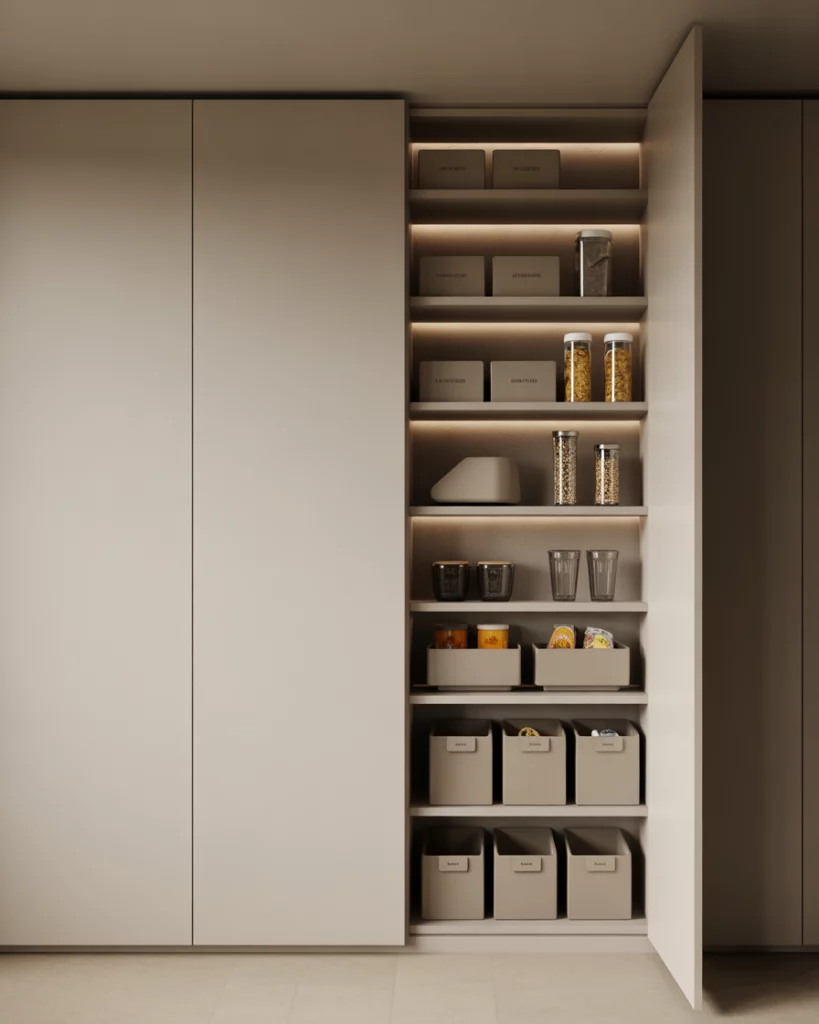
6. Small Closet Pantry Conversion for Tiny Homes
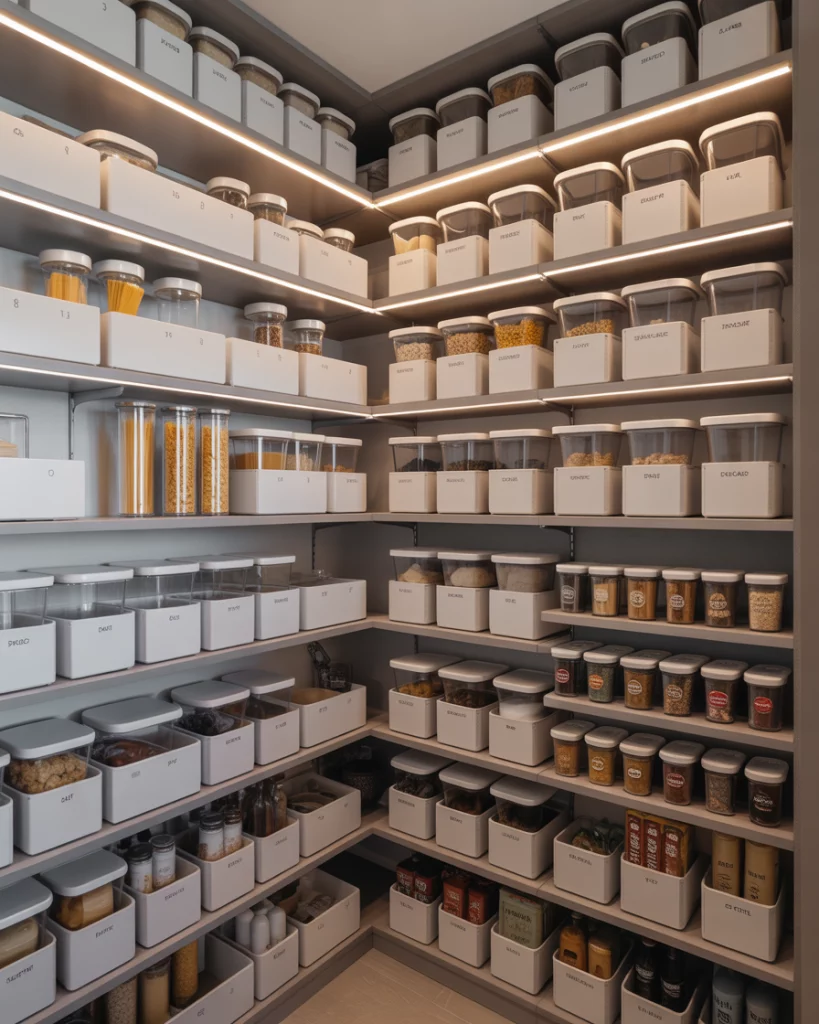 In a small house or apartment without a conventional pantry nearby, a small pantry closet nearby is a convenient option to make use of. Install shelving—fixed wood boards or wire shelving—and section off areas based on usage and accessibility—kids’ food at heights attainable by kids, cooking cans within adults’ easy reach, and bulk in higher shelving. Organizing containers will corral wandering foodstuffs such as individual spice packets or loose tea bags in one container. When I implemented this in my own first home after college in an off-campus apartment complex, it was a lifesaver in terms of preparation because everything was in a clear place around a coat cabinet turned pantry. This clever hack allows even smaller pantries to feel systematized.
In a small house or apartment without a conventional pantry nearby, a small pantry closet nearby is a convenient option to make use of. Install shelving—fixed wood boards or wire shelving—and section off areas based on usage and accessibility—kids’ food at heights attainable by kids, cooking cans within adults’ easy reach, and bulk in higher shelving. Organizing containers will corral wandering foodstuffs such as individual spice packets or loose tea bags in one container. When I implemented this in my own first home after college in an off-campus apartment complex, it was a lifesaver in terms of preparation because everything was in a clear place around a coat cabinet turned pantry. This clever hack allows even smaller pantries to feel systematized.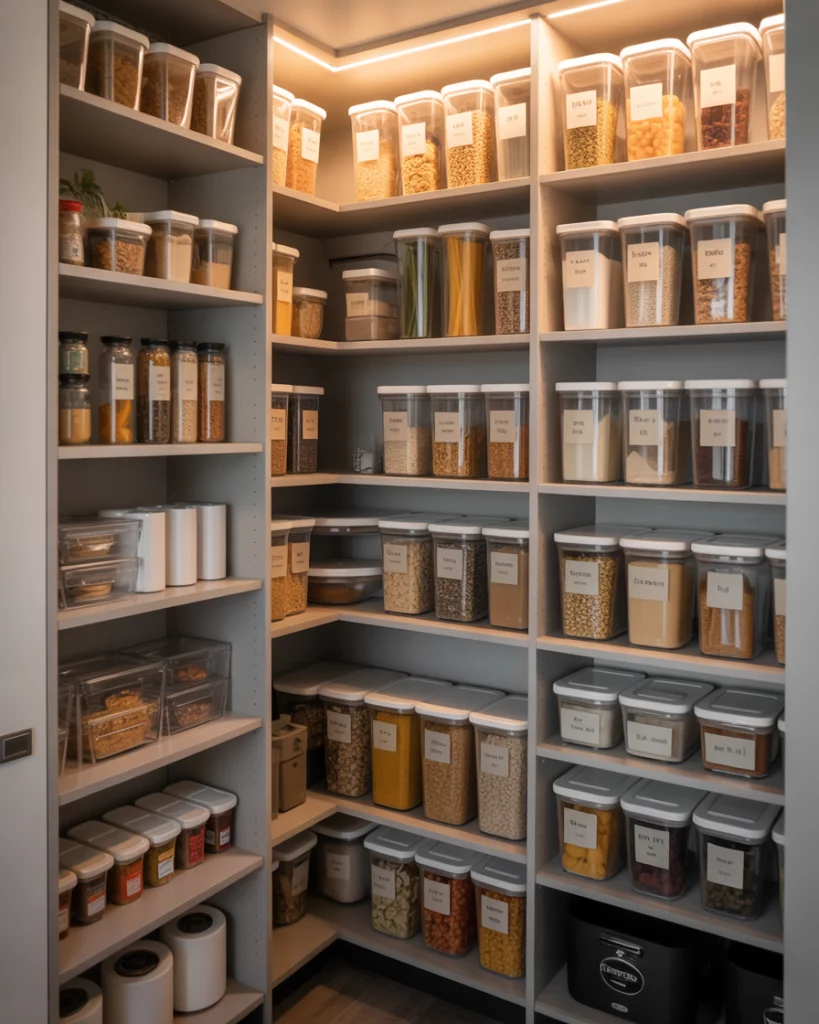
7. International-Inspired Spice & Staple Wall for Indian Cooking
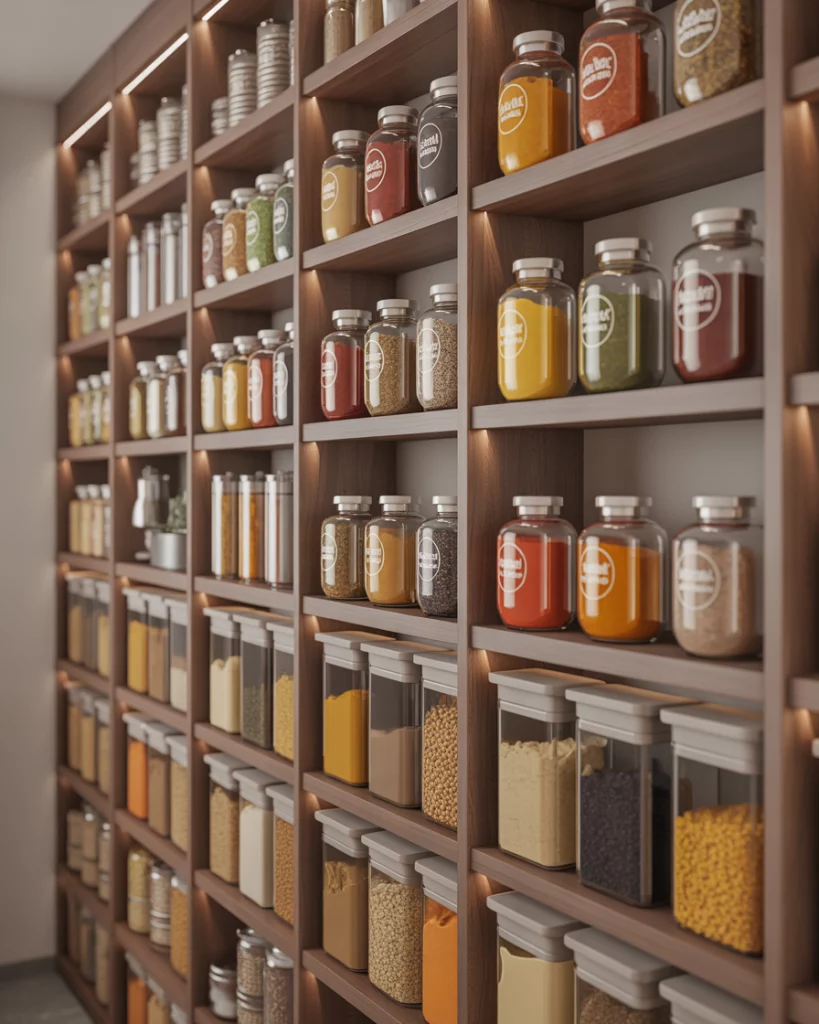 In a family’s cooking that incorporates a lot of spices—the cuisines of India, the Middle East, or Asia—carving out a whole wall of your pantry or a particular section thereof to keep your spices, lentils, pulses, or specialty grains is a great idea. Imagine this entire wall divided into wall-to-wall thin shelves that house labeled jars, magnetic containers, and multiple tiers for easy perusal. In fact, I visited a family cooking several meal prep activities in an Indian meal plan in a friend’s house, where they’d set up an extra-deep shelf for all 20+ spice jars, tiny containers of frequently rotated take-along treats, and common bulk purchases of rice and flours. This one station keeps all of your actual pantry organized.
In a family’s cooking that incorporates a lot of spices—the cuisines of India, the Middle East, or Asia—carving out a whole wall of your pantry or a particular section thereof to keep your spices, lentils, pulses, or specialty grains is a great idea. Imagine this entire wall divided into wall-to-wall thin shelves that house labeled jars, magnetic containers, and multiple tiers for easy perusal. In fact, I visited a family cooking several meal prep activities in an Indian meal plan in a friend’s house, where they’d set up an extra-deep shelf for all 20+ spice jars, tiny containers of frequently rotated take-along treats, and common bulk purchases of rice and flours. This one station keeps all of your actual pantry organized.
8. Healthy Snack Station for Busy Families
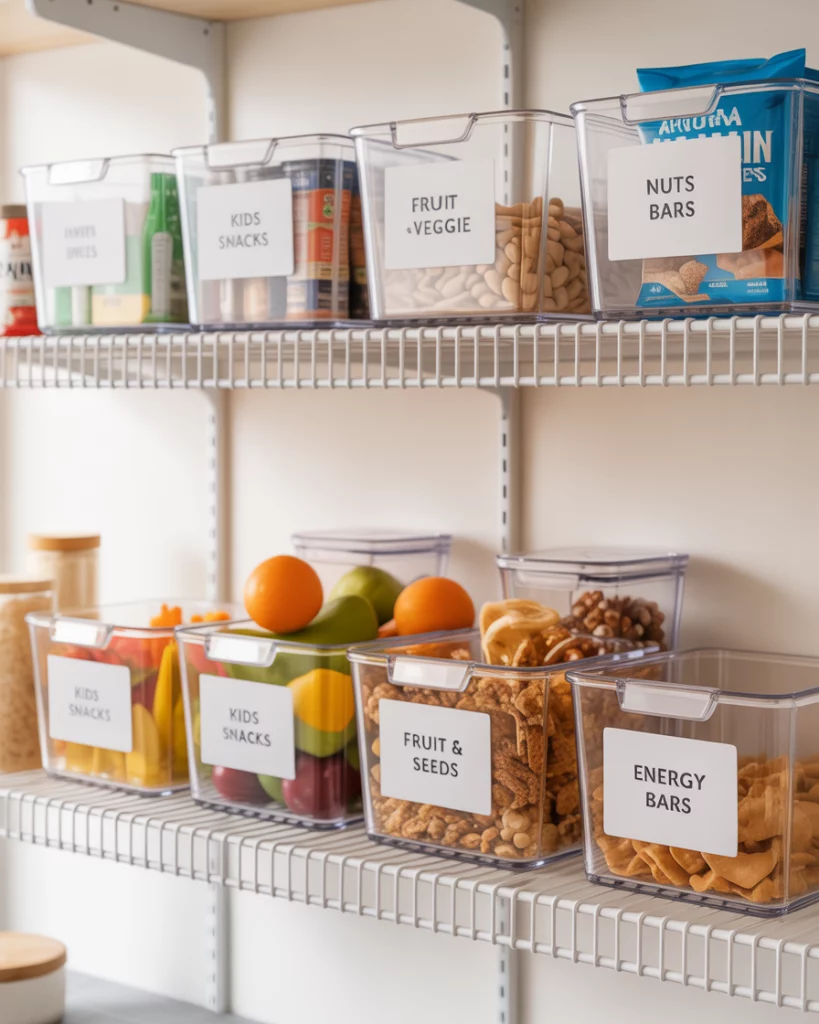 When in a busy house filled with family activities, or at least a family that engages in meal prep activities, an organized healthy snack station is an excellent innovation because it allows all family members easy immediate takeout without having to open all your cupboard doors. Reserve a shelf (or a drawer) specifically for a Grab & Go section of healthy food—to include pre-washed fruit, yogurt containers, granola bars, popcorn, or veggie sticks. Organized containers in a clear tub labeled “Kids’ Snacks,” “Adults’ Snacks,” or “Special Treasures” prevent confusion or after-school teens sneaking more goodies than they should. Organized pantries remain so because it is easy to forage in one section versus rifling through everything else.
When in a busy house filled with family activities, or at least a family that engages in meal prep activities, an organized healthy snack station is an excellent innovation because it allows all family members easy immediate takeout without having to open all your cupboard doors. Reserve a shelf (or a drawer) specifically for a Grab & Go section of healthy food—to include pre-washed fruit, yogurt containers, granola bars, popcorn, or veggie sticks. Organized containers in a clear tub labeled “Kids’ Snacks,” “Adults’ Snacks,” or “Special Treasures” prevent confusion or after-school teens sneaking more goodies than they should. Organized pantries remain so because it is easy to forage in one section versus rifling through everything else.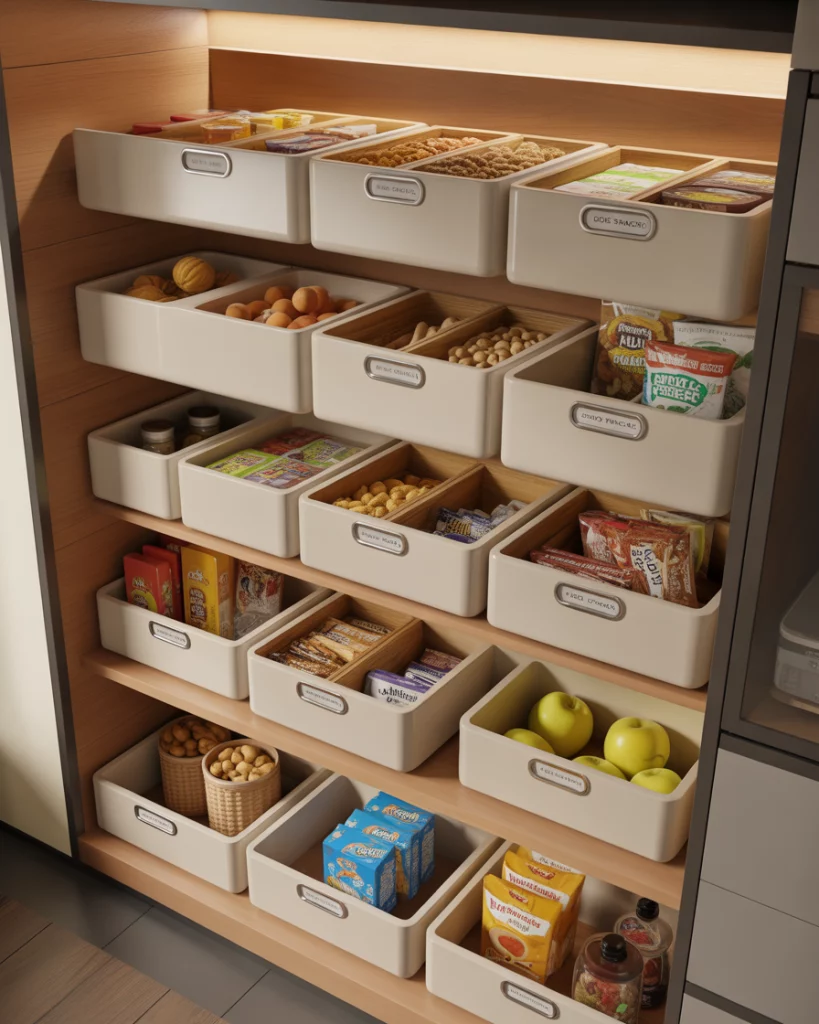
9. Smart Pull-Out Cabinet Installs for Quick Meals
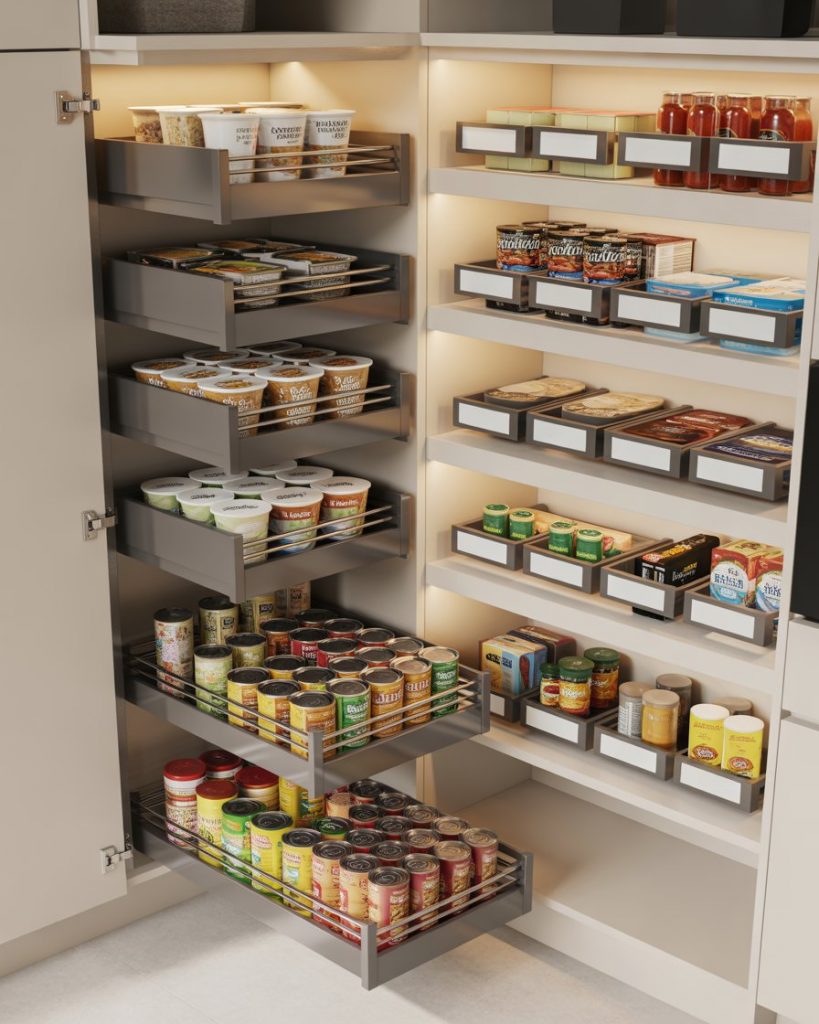 About a few years ago, a typical pantry consisted of static shelves. But it’s what’s emerging in 2026 that fascinates me—the use of pull-out trays, sliders, and accessories that draw out objects at your fingertips with a flick of your hand. Implement this in your pantry cabinet to dedicate a section of it to fast meal prep—buckets of canned soup, bags of frozen noodles, packages of sauce mix, and a surface area to compose a meal. I also assisted a client in placing a slide-out component in a butler’s pantry, or, as it’s also known, a “butler’s vault,” that allowed them to come home from work exhausted and have all meal components at their fingertips without digging through shelves. This is a huge functionality enhancer that’s affordable.
About a few years ago, a typical pantry consisted of static shelves. But it’s what’s emerging in 2026 that fascinates me—the use of pull-out trays, sliders, and accessories that draw out objects at your fingertips with a flick of your hand. Implement this in your pantry cabinet to dedicate a section of it to fast meal prep—buckets of canned soup, bags of frozen noodles, packages of sauce mix, and a surface area to compose a meal. I also assisted a client in placing a slide-out component in a butler’s pantry, or, as it’s also known, a “butler’s vault,” that allowed them to come home from work exhausted and have all meal components at their fingertips without digging through shelves. This is a huge functionality enhancer that’s affordable.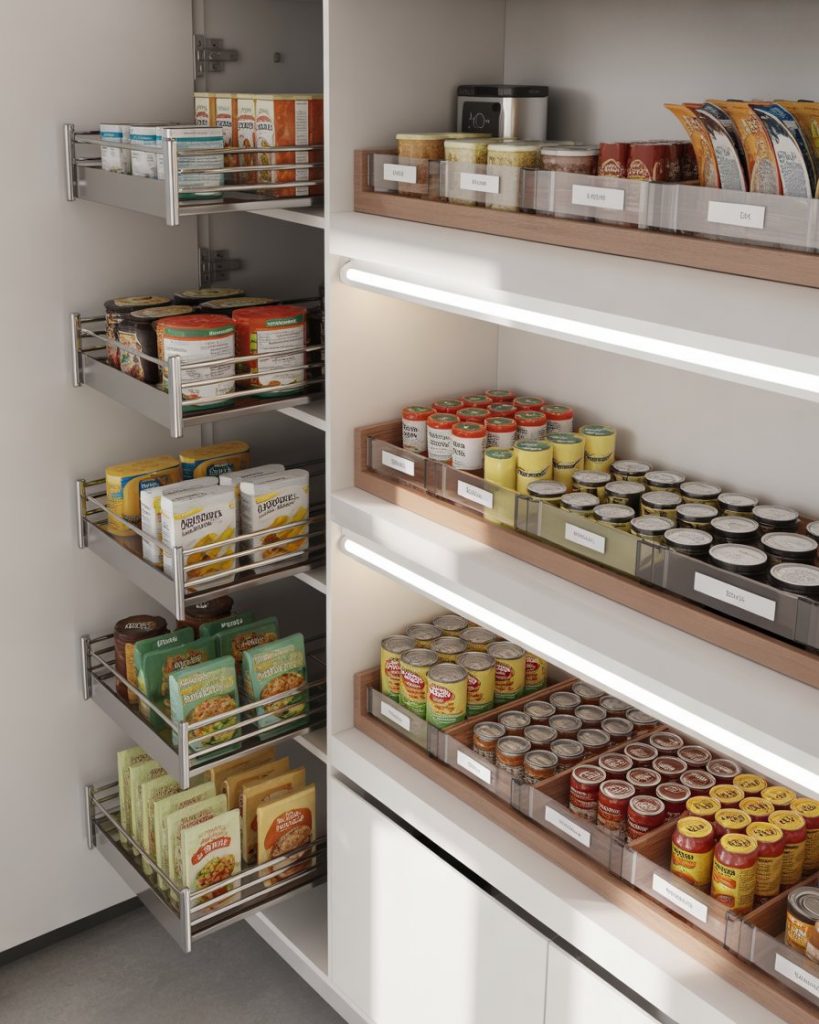
10. Apartment-Friendly Modular IKEA-Style Kits on a Budget
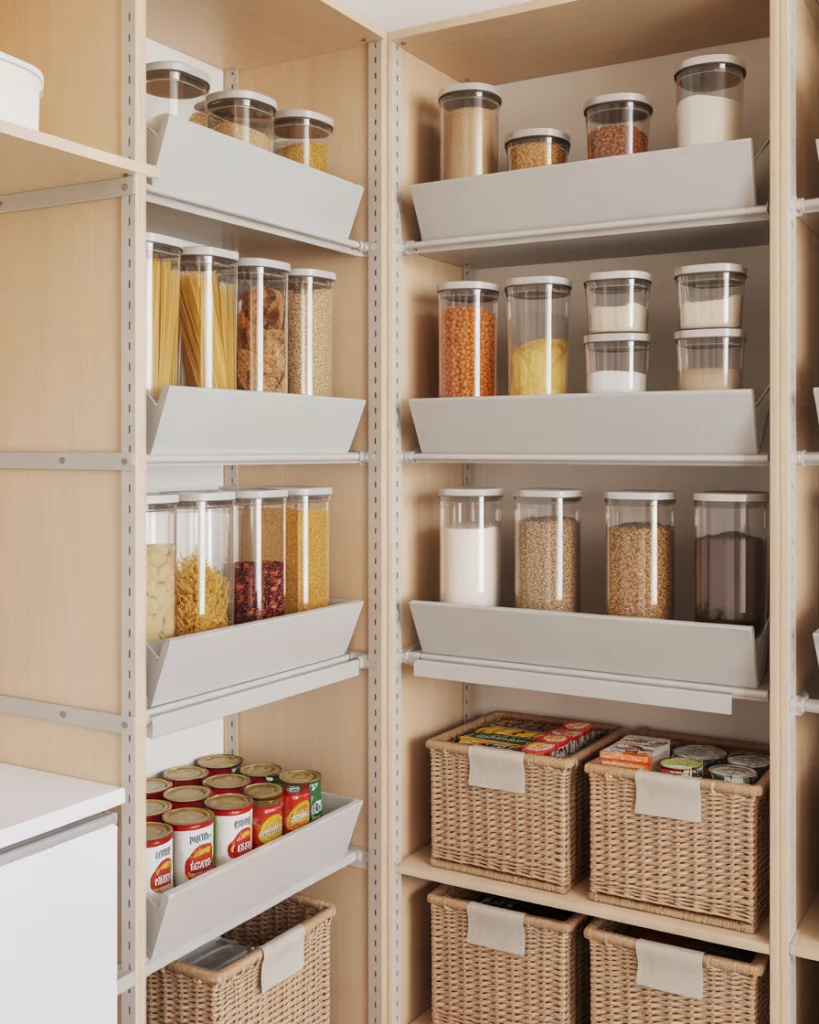 Renters or those in apartments thinking of relocating or rearranging often need solutions that are easy to take down and put back up again. Modular systems such as IKEA shelving units or similar units are a great alternative to start off with. This allows you to mix and match basic shelving units with accessories such as plastic containers, drawers, or wire baskets. Pick units that fit neatly in an awkward corner or against your kitchen wall. I constructed a full-blown pantry wall out of such a system and repainted shelving units with chalkboard paint so I could easily label units as I wanted. Inexpensive components = cheaper starter system = only doable for a limited budget. This was a total starter solution option.
Renters or those in apartments thinking of relocating or rearranging often need solutions that are easy to take down and put back up again. Modular systems such as IKEA shelving units or similar units are a great alternative to start off with. This allows you to mix and match basic shelving units with accessories such as plastic containers, drawers, or wire baskets. Pick units that fit neatly in an awkward corner or against your kitchen wall. I constructed a full-blown pantry wall out of such a system and repainted shelving units with chalkboard paint so I could easily label units as I wanted. Inexpensive components = cheaper starter system = only doable for a limited budget. This was a total starter solution option.
11. Sliding Door Pantry for Tight Kitchen Corners
 In smaller kitchens, traditional hinged doors take up valuable real estate in terms of functionality and “walking-through-space.” A slimmer option such as a farmer’s door or a sliding door converts an entire pantry system into a highly convenient one. One such neighbor of mine in an apartment decided to update an old-fashioned “ifold door” system with a smooth gliding one, allowing more walk-through clearance in a revamped ultramodernized aesthetic. To top it off, she utilized wire baskets & shelving units labeled successfully to use it as a baking center & treat cabinet. This system is a highly economical one that needs a lot less than it’s worth.
In smaller kitchens, traditional hinged doors take up valuable real estate in terms of functionality and “walking-through-space.” A slimmer option such as a farmer’s door or a sliding door converts an entire pantry system into a highly convenient one. One such neighbor of mine in an apartment decided to update an old-fashioned “ifold door” system with a smooth gliding one, allowing more walk-through clearance in a revamped ultramodernized aesthetic. To top it off, she utilized wire baskets & shelving units labeled successfully to use it as a baking center & treat cabinet. This system is a highly economical one that needs a lot less than it’s worth.
12. Under-Stair Pantry for Smart Storage
 If you have unused space under the stairs, turn it into a hidden pantry! With DIY ingenuity, you can add pull-out drawers, short wire shelves, and modular bins. I once helped a friend convert hers into a snack and beverage zone for busy families—we used lighting strips so she could see everything clearly. It became the most-used “closet” in the house. The design kept her kitchen clutter-free while offering easy access to bulk items.
If you have unused space under the stairs, turn it into a hidden pantry! With DIY ingenuity, you can add pull-out drawers, short wire shelves, and modular bins. I once helped a friend convert hers into a snack and beverage zone for busy families—we used lighting strips so she could see everything clearly. It became the most-used “closet” in the house. The design kept her kitchen clutter-free while offering easy access to bulk items.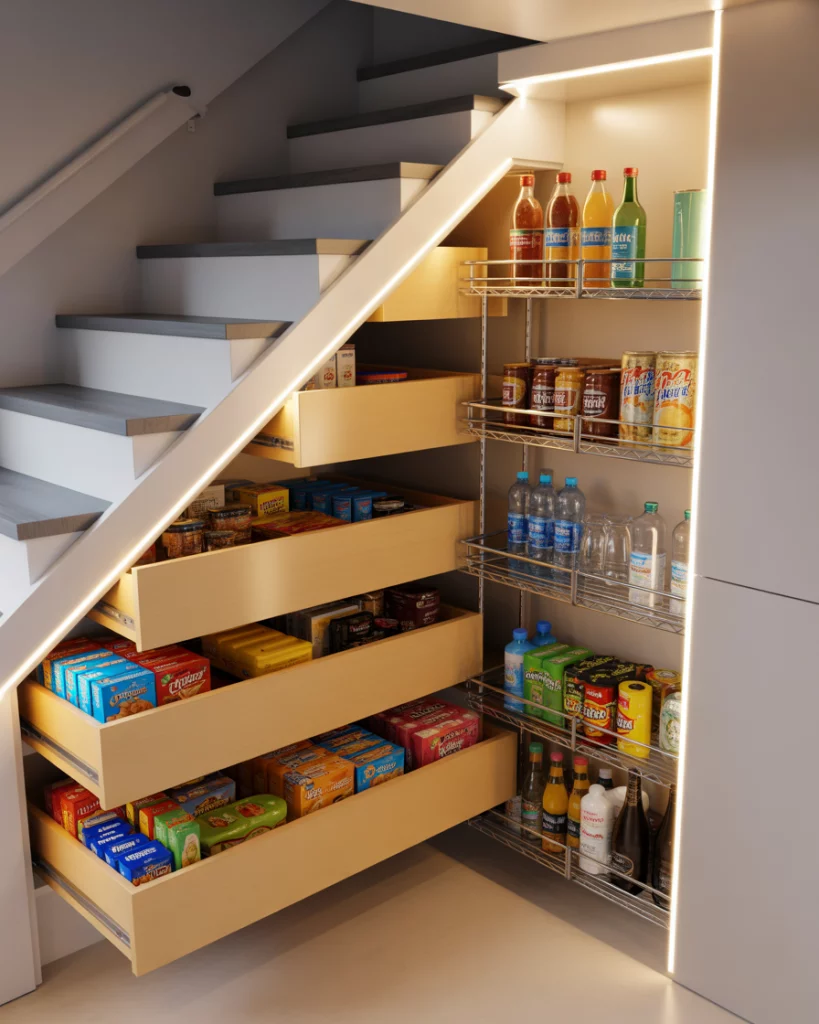
13. Glass Jar Display for a Minimalist Aesthetic
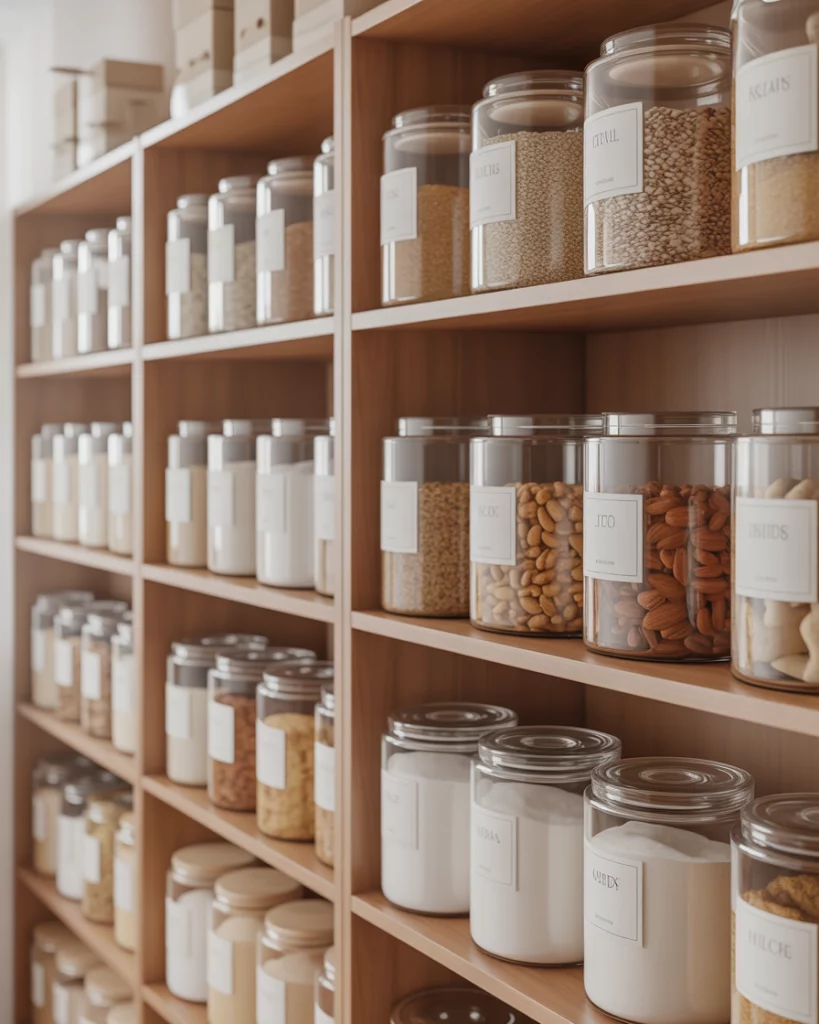 For those embracing a minimalist or eco-friendly lifestyle, swap plastic packaging for glass jars. Line them neatly on open shelves, grouping grains, nuts, and baking essentials. My sister started doing this to reduce plastic waste and says it’s also inspired healthier eating—she sees what she has at a glance. Use recycled jars to stay affordable, and add minimal chalk labels for elegance. It turns everyday essentials into décor.
For those embracing a minimalist or eco-friendly lifestyle, swap plastic packaging for glass jars. Line them neatly on open shelves, grouping grains, nuts, and baking essentials. My sister started doing this to reduce plastic waste and says it’s also inspired healthier eating—she sees what she has at a glance. Use recycled jars to stay affordable, and add minimal chalk labels for elegance. It turns everyday essentials into décor.
14. Corner Carousel Shelves for Small Spaces
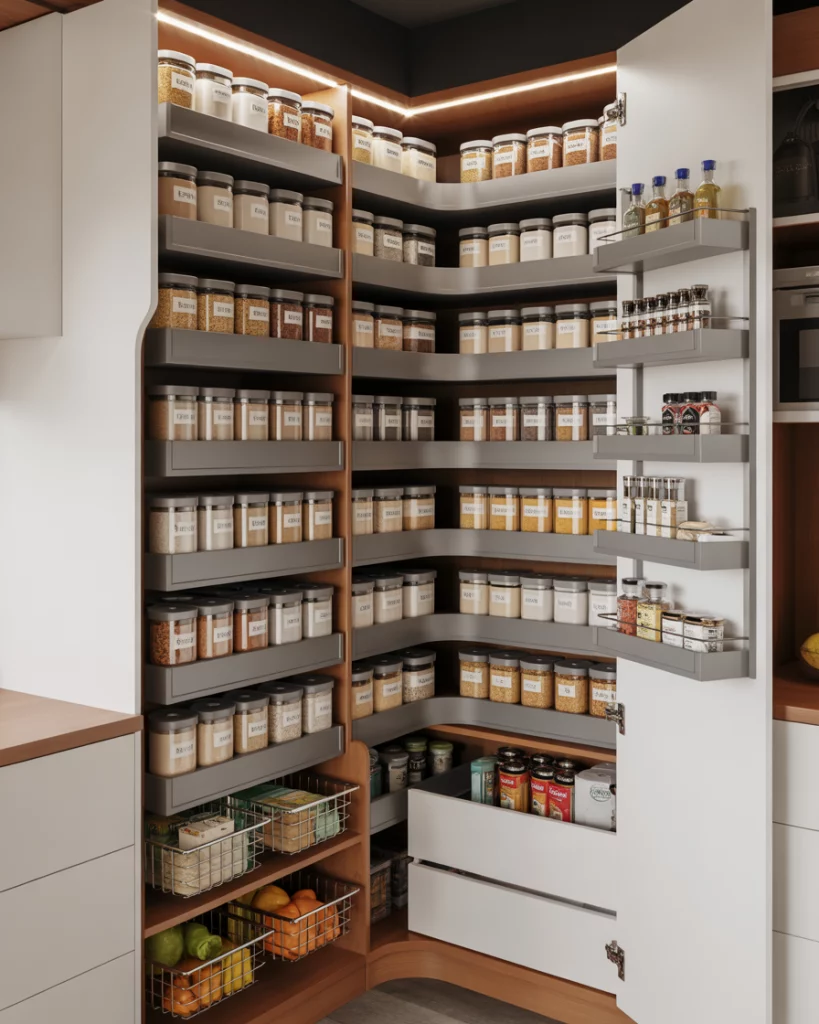 Corners can be tricky, but installing rotating carousel shelves helps maximize every inch. Perfect for small spaces or tiny pantries, these allow you to spin and access every item easily. I saw this first in a friend’s IKEA kitchen remodel—she stored her condiments and snacks and treats in them, and it looked both clever and chic. For a budget fix, you can find similar rotating trays at dollar stores or home centers.
Corners can be tricky, but installing rotating carousel shelves helps maximize every inch. Perfect for small spaces or tiny pantries, these allow you to spin and access every item easily. I saw this first in a friend’s IKEA kitchen remodel—she stored her condiments and snacks and treats in them, and it looked both clever and chic. For a budget fix, you can find similar rotating trays at dollar stores or home centers.
15. Butler’s Pantry Coffee and Breakfast Nook
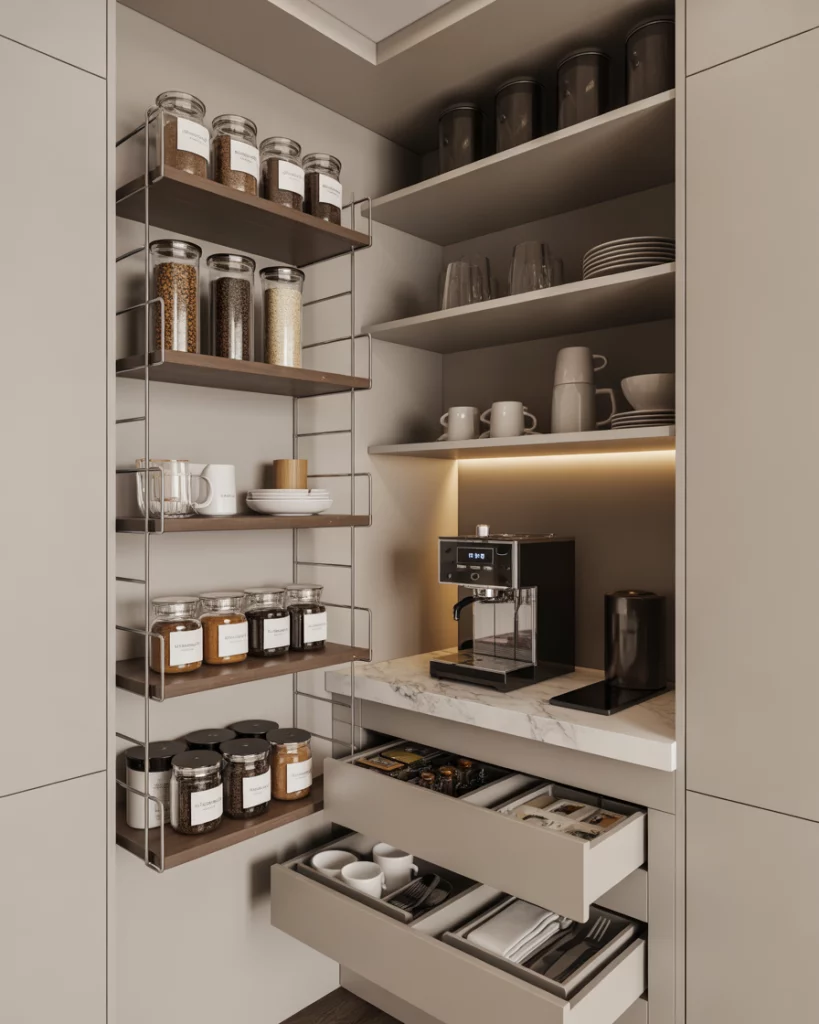 Transform part of your butler’s pantry into a dedicated coffee or breakfast nook. Imagine waking up and finding cereal, coffee beans, mugs, and toasters all organized in one compact zone. My neighbor, a mom of three, turned an old cabinet into her morning station using wire shelf risers for mugs and labeled jars for cereals. It saves time during chaotic mornings for busy families.
Transform part of your butler’s pantry into a dedicated coffee or breakfast nook. Imagine waking up and finding cereal, coffee beans, mugs, and toasters all organized in one compact zone. My neighbor, a mom of three, turned an old cabinet into her morning station using wire shelf risers for mugs and labeled jars for cereals. It saves time during chaotic mornings for busy families.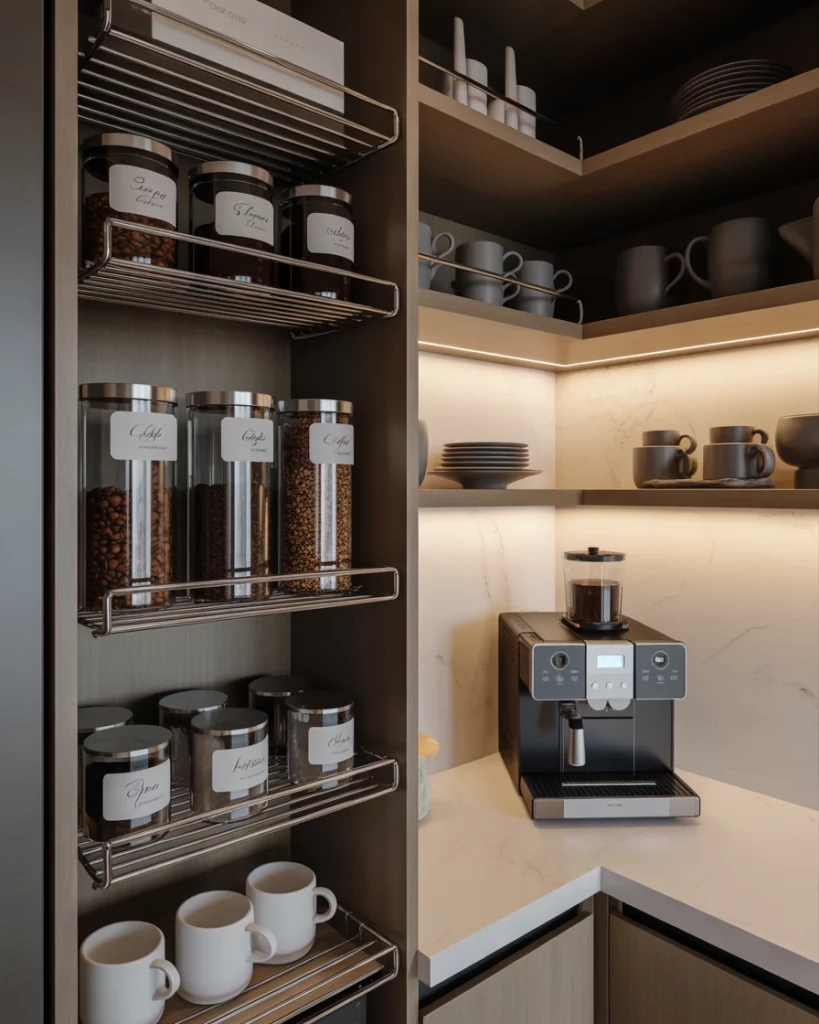
16. Pull-Down Pantry Racks for Small Closets
 A clever solution for a small closet or narrow pantry is installing pull-down racks that lower top-shelf items within reach. This feature—once seen only in luxury kitchens—is now found in affordable hardware stores. I helped an older couple install these, and they loved being able to access jars without ladders. Combine with clear bins and with labels for a user-friendly system.
A clever solution for a small closet or narrow pantry is installing pull-down racks that lower top-shelf items within reach. This feature—once seen only in luxury kitchens—is now found in affordable hardware stores. I helped an older couple install these, and they loved being able to access jars without ladders. Combine with clear bins and with labels for a user-friendly system.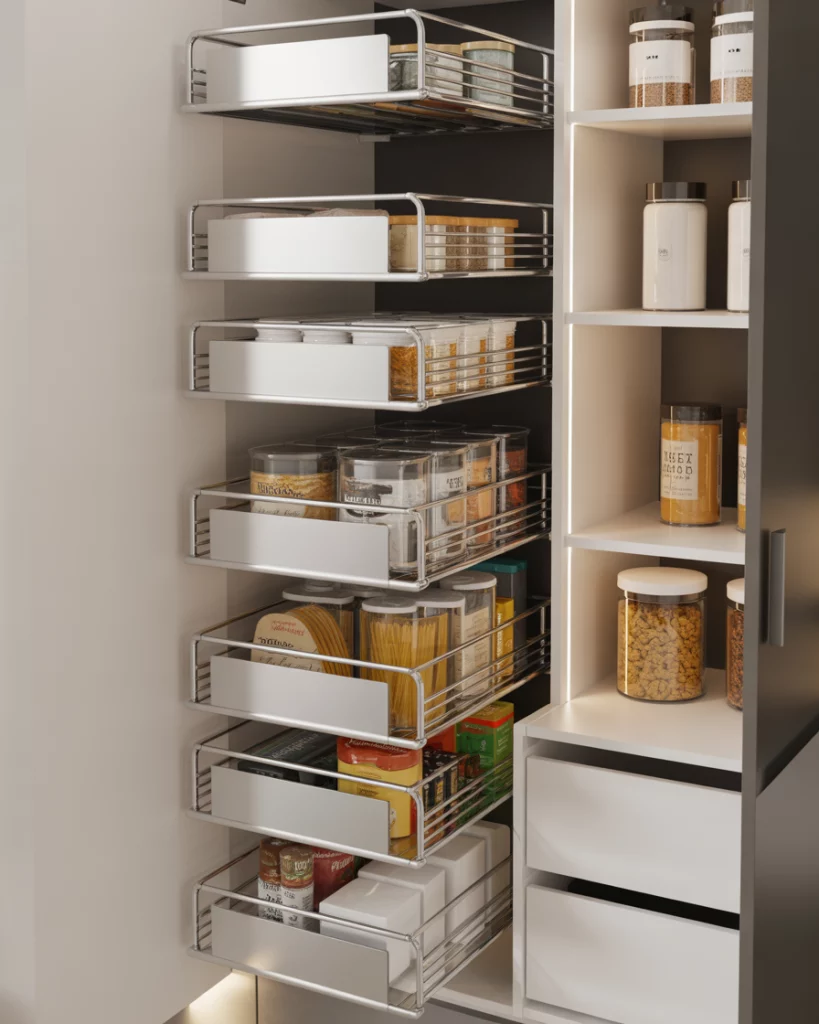
17. Budget-Friendly Wire Shelf Pantry for Apartments
 Many apartment dwellers skip traditional cabinetry and instead build open wire shelf pantries along one wall. This lightweight setup keeps costs low and looks surprisingly polished when coordinated with matching baskets and jars. I tried this in my first studio and found it made cooking simpler—I could see every ingredient. The key is staying consistent with containers to avoid visual clutter.
Many apartment dwellers skip traditional cabinetry and instead build open wire shelf pantries along one wall. This lightweight setup keeps costs low and looks surprisingly polished when coordinated with matching baskets and jars. I tried this in my first studio and found it made cooking simpler—I could see every ingredient. The key is staying consistent with containers to avoid visual clutter.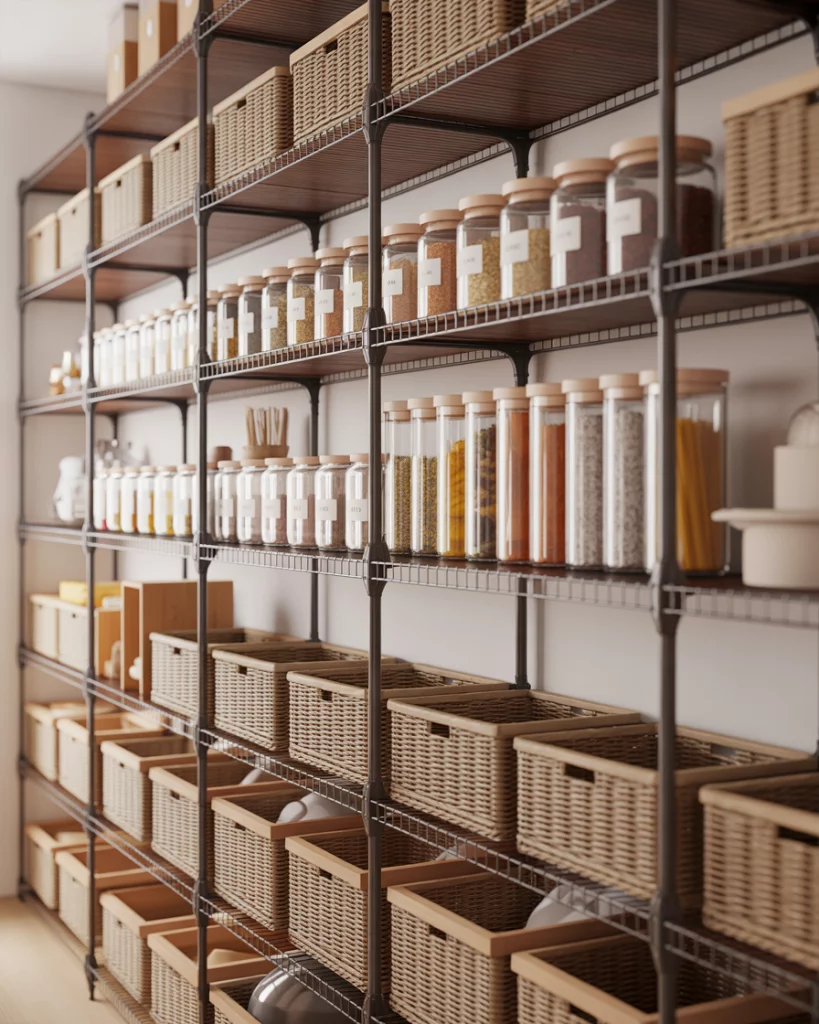
18. Color-Coded Pantry Organization Using labels
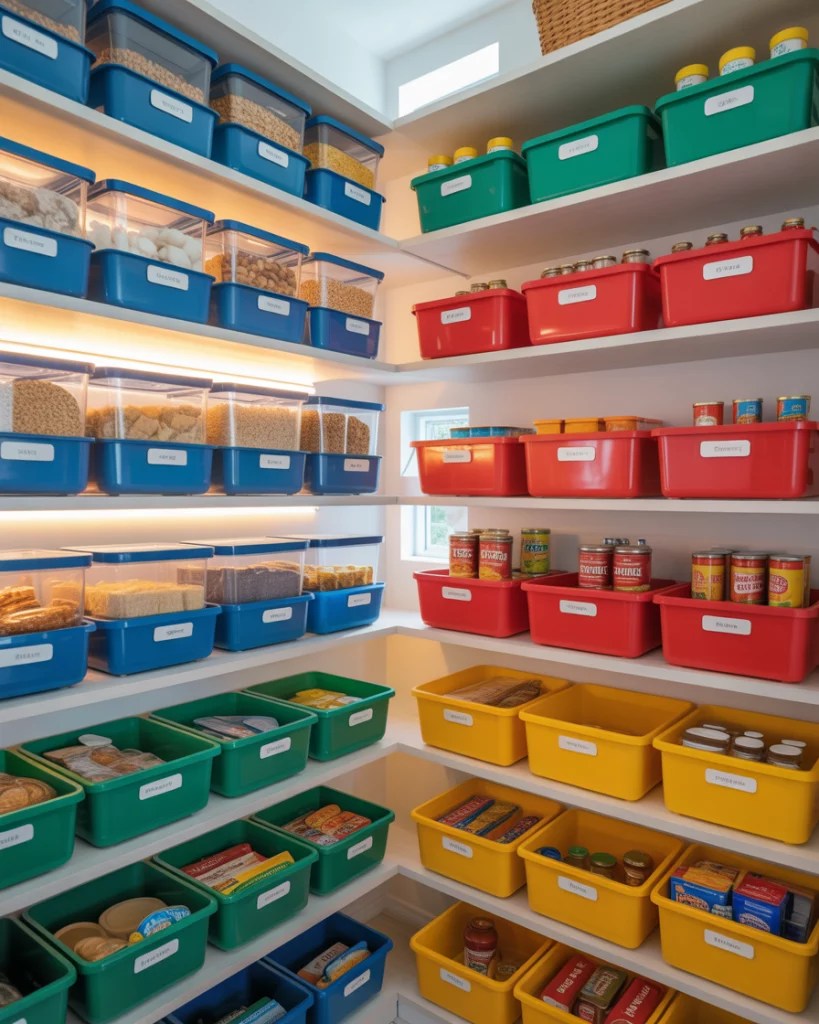 Color-coding is a game-changer for visualizers. You start by creating a system of choosing one or multiple colors per category, such as healthy foods in green, sauces in red, blue for baking, and yellows for treats in either colored containers or stickers. My niece implemented a version of this for helping children understand where everything belongs—to make cleanup fun. This system is also a great idea when multiple family members have frequent use of your pantry. Implementing a color-coding system in conjunction with labeled containers will maximize its benefits.
Color-coding is a game-changer for visualizers. You start by creating a system of choosing one or multiple colors per category, such as healthy foods in green, sauces in red, blue for baking, and yellows for treats in either colored containers or stickers. My niece implemented a version of this for helping children understand where everything belongs—to make cleanup fun. This system is also a great idea when multiple family members have frequent use of your pantry. Implementing a color-coding system in conjunction with labeled containers will maximize its benefits.
19. Rustic Open Pantry with a Farmhouse Vibe
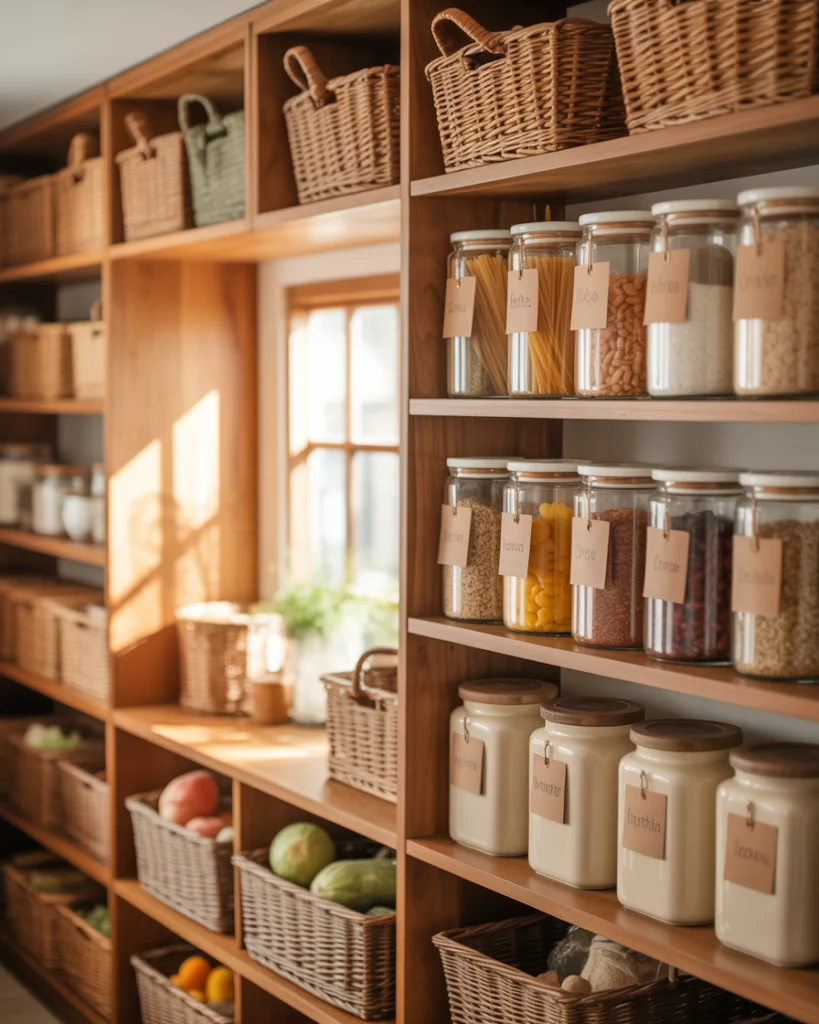 For those who adore a farmhouse style, consider leaving your pantry open with wooden shelves, woven baskets, and ceramic containers. Keep it rustic yet neat—think whitewashed boards, handwritten labels, and small décor touches like vintage scales. A friend of mine calls hers “the heart of the house” because she chats there while cooking. This setup feels both nostalgic and contemporary, perfectly blending warmth and function.
For those who adore a farmhouse style, consider leaving your pantry open with wooden shelves, woven baskets, and ceramic containers. Keep it rustic yet neat—think whitewashed boards, handwritten labels, and small décor touches like vintage scales. A friend of mine calls hers “the heart of the house” because she chats there while cooking. This setup feels both nostalgic and contemporary, perfectly blending warmth and function.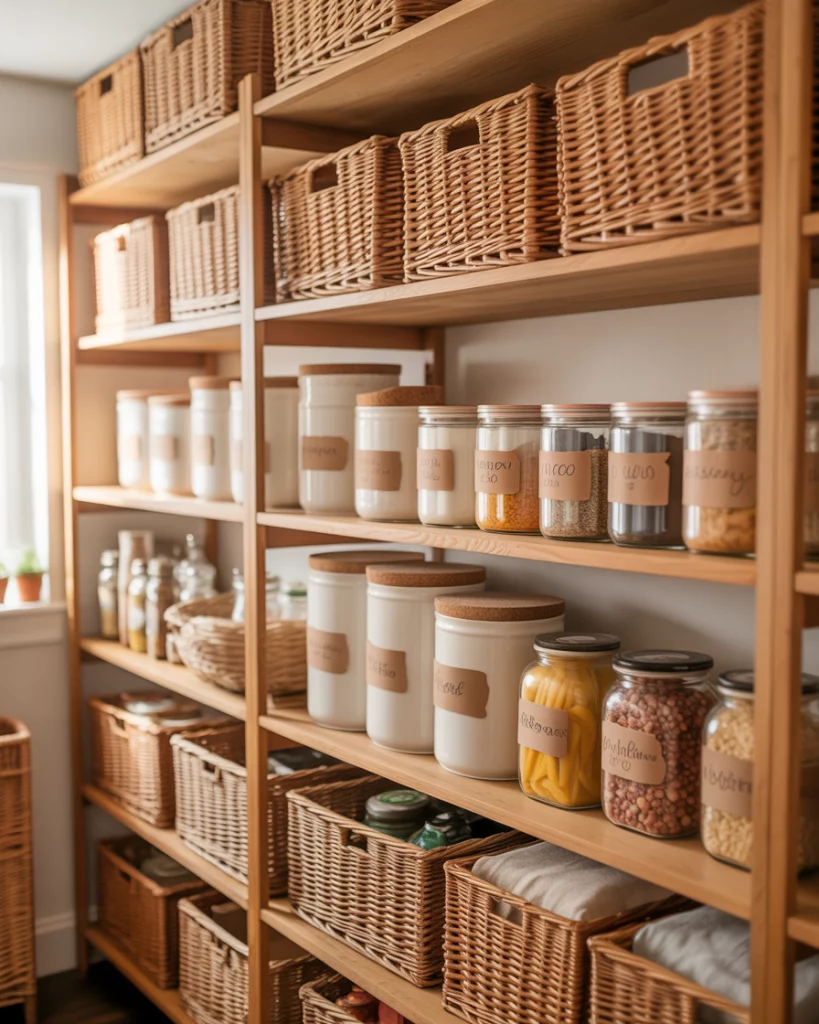
20. Tech-Smart Pantry with Inventory Apps and QR Labels
 The future of pantry organization in 2026 includes technology! Use QR code labels that link to inventory apps to track what’s running low. I tested one such system and found it reduced waste—no more three bags of flour or expired sauces. Combine smart tracking with wire shelves and modular bins for easy scanning. It’s a futuristic yet affordable upgrade that modern busy families love.
The future of pantry organization in 2026 includes technology! Use QR code labels that link to inventory apps to track what’s running low. I tested one such system and found it reduced waste—no more three bags of flour or expired sauces. Combine smart tracking with wire shelves and modular bins for easy scanning. It’s a futuristic yet affordable upgrade that modern busy families love.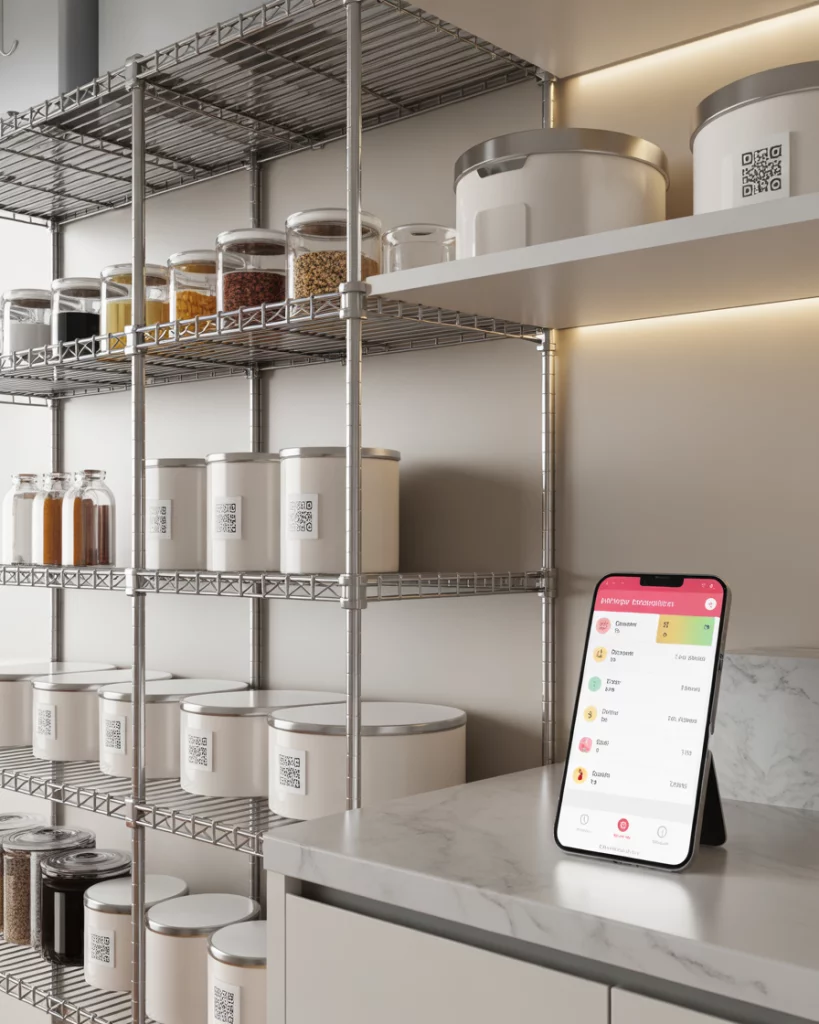
21. Floating Shelf Pantry for Tiny Apartments
 When every inch counts in tiny apartments or studios, floating shelves can be your best ally. Mount them above counters or along unused walls near your kitchen. I once saw a renter in New York use four sturdy floating boards, creating an airy open pantry filled with labeled jars and snacks and treats. She even tucked a small herb garden beneath the lowest shelf. It’s a DIY project that costs little but looks custom and stylish.
When every inch counts in tiny apartments or studios, floating shelves can be your best ally. Mount them above counters or along unused walls near your kitchen. I once saw a renter in New York use four sturdy floating boards, creating an airy open pantry filled with labeled jars and snacks and treats. She even tucked a small herb garden beneath the lowest shelf. It’s a DIY project that costs little but looks custom and stylish.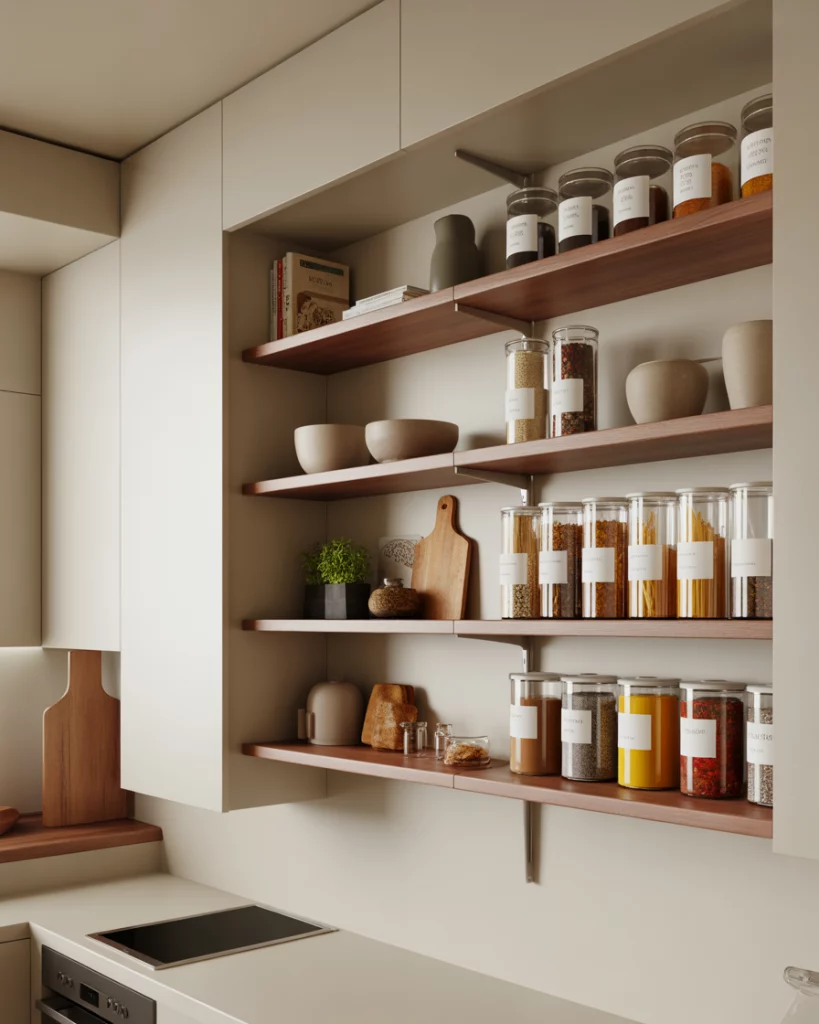
22. Hidden Pull-Out Pantry Beside the Fridge
 If your kitchen feels cramped, a slender pull-out rack beside the fridge can work wonders. This vertical pantry—built on a budget—slides out to reveal tall wire shelves perfect for canned goods, oils, or cereal boxes. My cousin built one himself using affordable IKEA rails and DIY plywood sides, instantly adding usable storage without touching existing cabinets. It’s sleek, space-saving, and totally renter-friendly.
If your kitchen feels cramped, a slender pull-out rack beside the fridge can work wonders. This vertical pantry—built on a budget—slides out to reveal tall wire shelves perfect for canned goods, oils, or cereal boxes. My cousin built one himself using affordable IKEA rails and DIY plywood sides, instantly adding usable storage without touching existing cabinets. It’s sleek, space-saving, and totally renter-friendly.
23. Seasonal Rotation Pantry System for Busy Families
 For busy families, clutter is often a product of full pantries all year round. Try a seasonal rotation—you keep only that which you need in a particular season and put the rest in boxes. My aunt, a baker extraordinaire, keeps a rotation of Christmas spices in labeled containers toward the top shelf. She switches them out every three months. It’s fresh, it’s waste-free, and it’s simply more organized. Bonus points? You plan your fast meals sooner when you have a system that rotates products regularly.
For busy families, clutter is often a product of full pantries all year round. Try a seasonal rotation—you keep only that which you need in a particular season and put the rest in boxes. My aunt, a baker extraordinaire, keeps a rotation of Christmas spices in labeled containers toward the top shelf. She switches them out every three months. It’s fresh, it’s waste-free, and it’s simply more organized. Bonus points? You plan your fast meals sooner when you have a system that rotates products regularly.
24. Affordable Butler’s Pantry Makeover with Farmhouse Charm
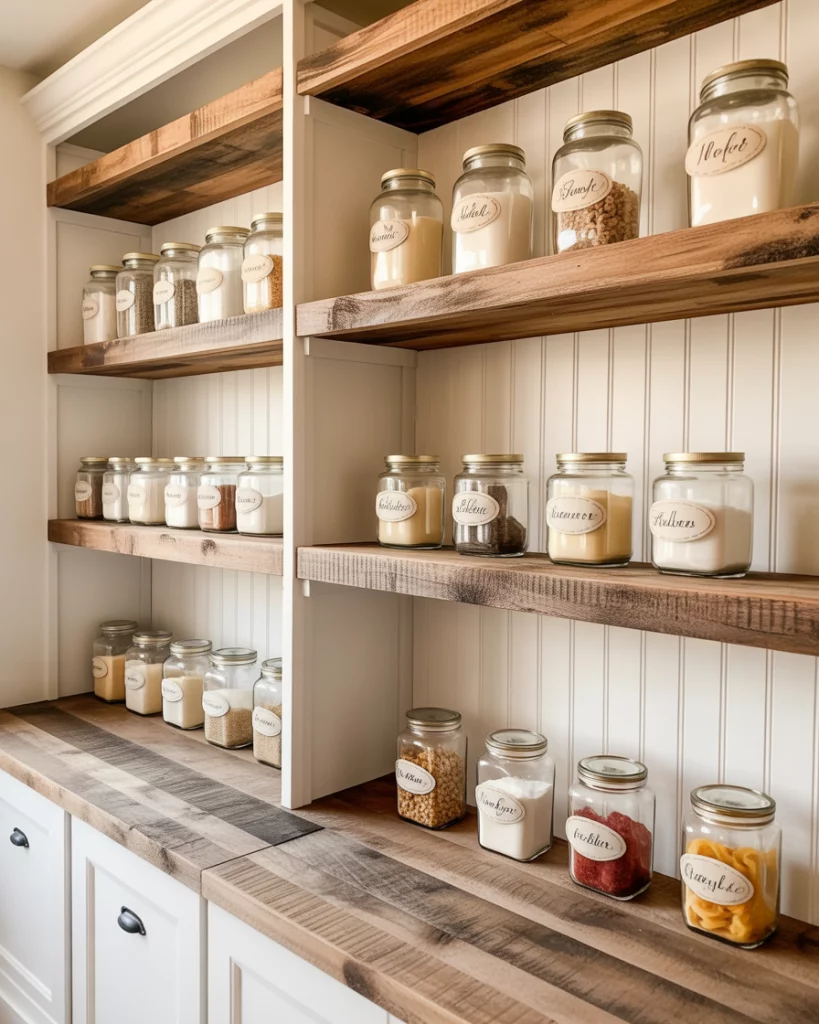 If you have a butler’s pantry or a spare nook, you can give it a cozy farmhouse-style facelift without overspending. Add reclaimed wood shelves, white beadboard backing, and black metal brackets. I helped a friend create this with paint, thrifted baskets, and Dollar Tree jars—it looked straight out of a design magazine. Even on a budget, you can make it feel warm, coordinated, and full of personality.
If you have a butler’s pantry or a spare nook, you can give it a cozy farmhouse-style facelift without overspending. Add reclaimed wood shelves, white beadboard backing, and black metal brackets. I helped a friend create this with paint, thrifted baskets, and Dollar Tree jars—it looked straight out of a design magazine. Even on a budget, you can make it feel warm, coordinated, and full of personality.
In wrapping up, these ten ideas cover everything from high-end walk-in pantries to DIY dollar-store conversions, from wire shelving to farmhouse style, from dedicated cooking zones to healthy snack stations, and from small apartment hacks to full-scale solutions.

